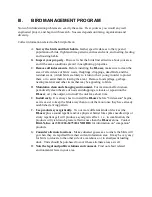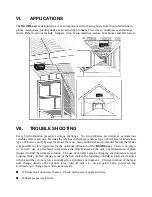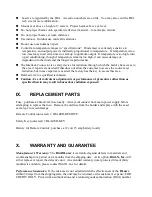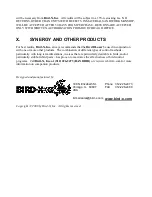
III.
BIRD MANAGEMENT PROGRAM
No two bird infestation problems are exactly the same. Treat yours as you would any well
engineered project, and begin with research. Success depends on timing, organization and
diversity.
Collect information related to the bird problem:
A.
Survey the birds and their habits.
Gather specific data as to the type and
population of birds, flight and time patterns, entries and exits, and nesting, feeding
and roosting habits.
B.
Inspect your property.
Discover what the birds find attractive about your area,
and if the same conditions prevail in neighboring properties.
C.
Remove all inducements.
Before installing the
BLazer,
make sure to clean the
area of all evidence of birds: nests, fledglings, droppings, dead birds, and the
residual scent. (Adult birds are likely to return to their young in order to protect
them or to assist them in leaving the area.) Remove food spillage, garbage,
nesting material and other items that may be appealing to birds.
D.
Maintain a clean and changing environment.
For maximum effectiveness,
periodically clean the area of nests and droppings, relocate or reposition the
BLazer
, vary the output, or turn off the unit for a short time.
E.
Install early.
It is always best to install the
BLazer
before "bird season" begins,
as it is easier to keep the birds away than to rout them out once they have already
established a living pattern.
F.
Use products synergistically.
Two or more different kinds of devices (the
BLazer
plus a sound repeller and/or a physical barrier like spikes needle strips or
sticky repellent gel) will produce a synergistic effect – i.e., in combination, the
products will yield much greater effectiveness than the
BLazer
alone. Contact
Bird-X, Inc. at (312) 226-2473 (BAN BIRD)
for information on "companion"
products.
G.
Consider alternate locations.
Make educated guesses as to where the birds will
go when they are repelled from their current infestation area. It may be very easy
for birds to relocate to the other side of a warehouse, or to an adjacent loading
dock. Units should be purchased to cover these alternate areas as well.
H.
Note the legal and public relations environment.
Find out about related
environmental laws in your area.



























